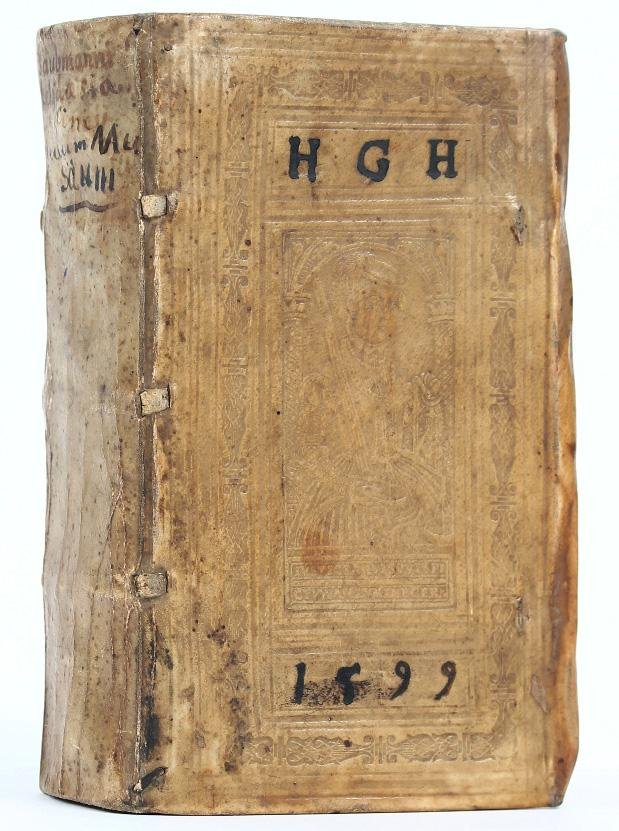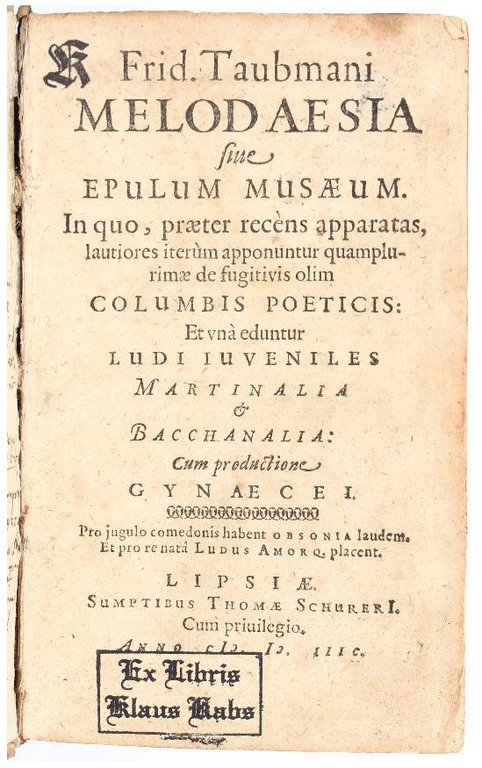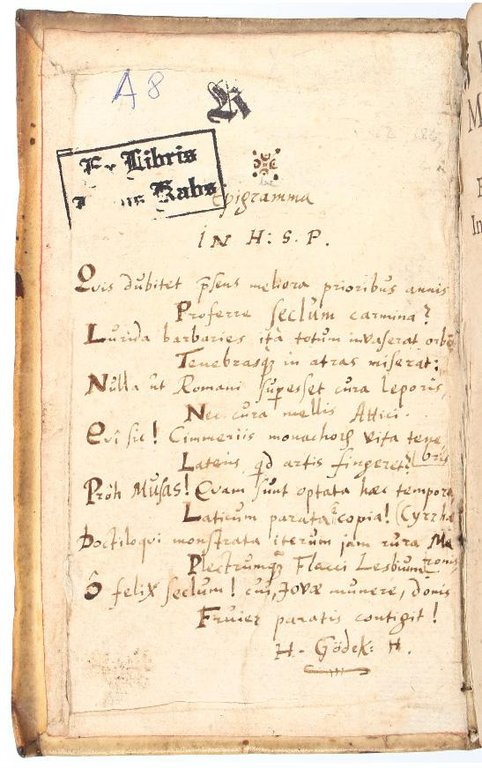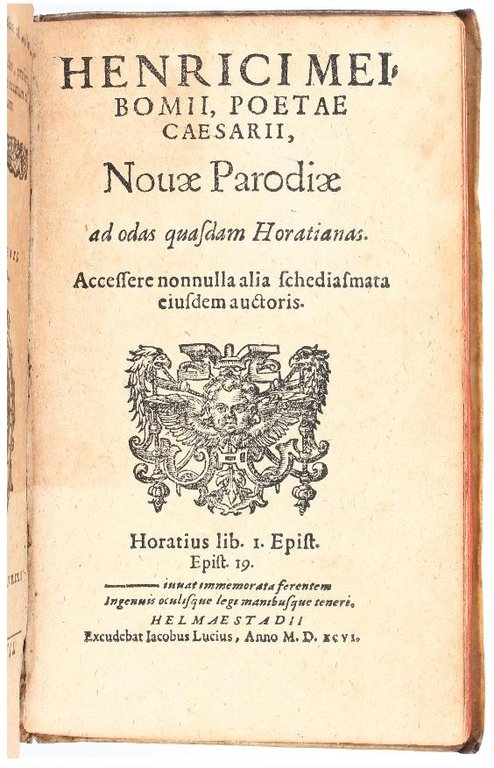





Libri antichi e moderni
TAUBMANN, Friedrich (1565-1613)
Melodaesia sive epulum musaeum. In quo, praeter recèns apparatas, lautiores iterùm apponuntur quamplurimae de fugitivis olim columbis poeticis: Et unà eduntur Ludi iuveniles Martinalia & Bacchanalia: Cum production Gynaecei
Michael Lantzenberger for Thomas Schürer, 1597
3400,00 €
Govi Libreria Antiquaria
(Modena, Italia)
Le corrette spese di spedizione vengono calcolate una volta inserito l’indirizzo di spedizione durante la creazione dell’ordine. A discrezione del Venditore sono disponibili una o più modalità di consegna: Standard, Express, Economy, Ritiro in negozio.
Condizioni di spedizione della Libreria:
Per prodotti con prezzo superiore a 300€ è possibile richiedere un piano rateale a Maremagnum. È possibile effettuare il pagamento con Carta del Docente, 18App, Pubblica Amministrazione.
I tempi di evasione sono stimati in base ai tempi di spedizione della libreria e di consegna da parte del vettore. In caso di fermo doganale, si potrebbero verificare dei ritardi nella consegna. Gli eventuali oneri doganali sono a carico del destinatario.
Clicca per maggiori informazioniMetodi di Pagamento
- PayPal
- Carta di Credito
- Bonifico Bancario
-
-
Scopri come utilizzare
il tuo bonus Carta del Docente -
Scopri come utilizzare
il tuo bonus 18App
Dettagli
Descrizione
(bound with:)
MEIBOM, Heinrich (1555-1625). Novae parodiae ad odas quasdam Horatianas. Acessere nonnulla alia schediasmata eiusdem auctoris. Helmstadt, Jacob Lucius, 1596.
Two works in one volume (158x96 mm). Contemporary blind-stamped vellum with overlapping edges and inked title on spine, front panel with “Iustitia” stamp (signed with the monogram “D P”, see Haebler I, 325), and the initials “HGH” and date “1599” in black ink, back panel with “Casta Lucretia” stamp (unsigned and undated), red edges (lacking the ties). Taubmann: [24], 614, [10] pp. Collation: )(8 ):(4 A-Z8 Aa-Qq8. Printer's device on the last page. Meibom: [32] leaves. Collation: A-D8. Woodcut ornament on the title page, full-page woodcut coat-of-arms on title-page verso. On the front pastedown, on the first title page and on the following leaf stamps “Ex-libris Klaus Kabs” and “KT”. On the front pastedown handwritten poem in a contemporary hand “Epigramma in H:S.P.” signed by H. Gödek H., i.e. the dean of Hildesheim und Poeta Laureatus Heinrich Gödeke (Henricus Goedekenius Hildesianus, 1580-1609, see J.L. Flood, Poets Laureate in the Holy Roman Empire: A Bio-bibliographical Handbook, Berlin/Boston, 2019, II, pp. 680-681), who is also the person who commissioned the binding. On the back flyleaf and pastedown one or two contemporary hands have copied a few verses from Ovid and some epigrams of Albertus de Rosati and Johannes Monachus. Small oxidation hole to l. Pp6 (pp. 603/604) with some loss of text, browned throughout, some foxing and staining, but overall a very good, genuine copy in a nice, signed and dated contemporary binding.
I. FIRST EDITION. Taubmann's most successful and comprehensive collection of neo-Latin poetry, which was reprinted in 1604, 1615, 1622 and in 1634. It was dedicated to two of his major patrons: “Friedrich Taubmann gestaltet die Widmungsadresse zu seine Melodaesia an Friedrich Wilhelm I., Herzog von Sachsen-Weimar (1562-1602) und Georg Friedrich I., Markgraf von Brandenburg (1539-1603), als doppelseitige, dyptichonartige Inschrift, die er mit der antiken römischen epigraphischen Weiheformel ‘Libens merito offert consecratque' abschliesst. Nach der Inschrift folgt direkt der erste Satz der Widmung” (K.A.E. Enenkel, Die Stiftung von Autorschaft in der neulateinischen Literatur, ca. 1350-ca. 1650: zur autorisierenden und wissensvermittelden Funktion von Widmung, Vorworttexten, Autorportraits und Dedikationsbildern, Leiden, 2014, p. 119).
The volume contains the following sections: Sacrorum Libri II (pp. 1-76); Bellum Angelicum Librorum III (pp. 77-107); Amores et Delitiae (pp. 108-123); Anacreon Latinus (pp. 123-142); Epicorum Libri II (pp. 143-197); Lyricorum Liber I (pp. 198-224); Phaleucorum Libri II (pp. 224-287); Elegiarum Liber I (pp. 288-324); Epigrammatum Libri VI (pp. 324-510; Philothesia (pp. 511-528); Juvenilia [Martinalia, Bacchanalia, Commentum de magno Christophoro, Gynaeceum poeticum] (pp. 528-592); Epistolae aliquot (pp. 592-614). Some of the work listed here were already issued before, such as the epyllion on the Saint Martin's day goose, the Martinalia, and the first neo-Latin carnival epic written in Germany, Bacchanalia, both written at Heilbronn around 1587 and printed at Wittenberg as Lusus duo pueriles in 1592 (cf. H. Wiegand, Bacchanalia Neo-Latina. Zur Rezeption antiker Karnevalsmotive in der neulateinischen Literatur, in: “Karnevaleske Phänomene in antiken und nachantiken Kulturen und Literaturen”, S. Dopp, ed., Trier, 1993, pp. 265-286). Also, a part of the earlier collection of poems, Columbae poeticae (Wittenberg, 1594) and Amores (Wittenberg, 1596), were incorporated, partly revised in Melodaesia.
“Still, the most influential poet in the further development of Latin Anacreontics was the professor of poetry in Wittenberg, Friedrich Taubmann […] To account for the impact of

